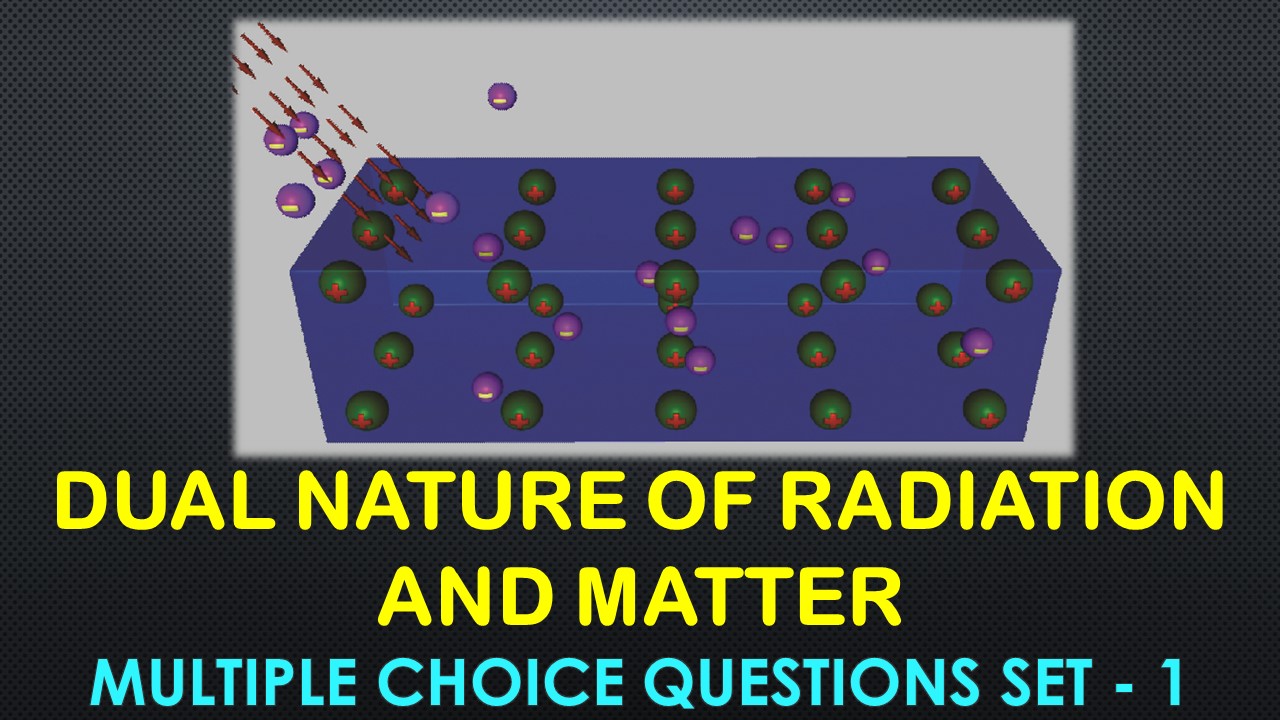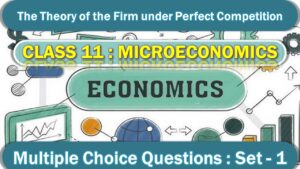CBSE Class 12 Dual Nature of Radiation and Matter Multiple Choice Questions with Answers. MCQ Questions Class 12 Dual Nature of Radiation and Matter with Answers Is Prepared Based on Latest Exam Pattern. Students can solve NCERT Class 12 Dual Nature of Radiation and Matter MCQs with Answers to know their preparation level.
Students who are searching for NCERT MCQ Questions for Class 12 Dual Nature of Radiation and Matter with Answers are compiled here to get good practice on all fundamentals. Know your preparation level on MCQ Questions for Class 12 Dual Nature of Radiation and Matter with Answers. You can also verify your answers from our provided MCQ Class 12 Dual Nature of Radiation and Matter with Answers. So, ace up your preparation with MCQ of Class 12 Physics Examinations.
MCQ Questions Class 12 Dual Nature of Radiation and Matter with Answers - Set - 1
Question 1:
Which of the following is not the property of photons
(a) charge
(b) rest mass
(c) Both A &B
(d) momentum
Correct Answer – (C)
Question 2 :
The threshold frequency for a certain metal is v0. When light of frequency v = 2v0 is incident on it, the maximum velocity of photo electrons is 4 × 106 ms-1. If the frequency of incident radiation is increased to 5 v0, then the maximum velocity of photo electrons (m/s) is
(a) 8 × 105
(b) 2 × 106
(c) 2 × 107
(d) 8 × 106
Correct Answer – (D)
Question 3 :
A photocell is illuminated by a small bright source placed 1 metre away. When the same source of light is placed 2 m away, the electrons emitted per sec. (i.e. saturation current in the photo cell is) are
(a) I ∝ 2²
(b) I ∝ 1/4
(c) I ∝ 4
(d) I ∝ 1/2
Correct Answer – (B)
Question 4 :
Ultra-violet radiation of 6.2 eV falls on an aluminium surface having work-function 4.2 eV. The kinetic energy (in J) of the fastest electron emitted is nearly.
(a) 3 × 10-19
(b) 3 × 10-15
(c) 3 × 10-17
(d) 3 × 10-21
Correct Answer – (A)
Question 5 :
The de-Broglie wavelength of an electron moving with a speed of 6.6 × 1015 ms-1 is nearly equal to
(a) 10-11m
(b) 10-9 m
(c) 10-7 m
(d) 10-5 m
Correct Answer – (B)
MCQ Questions Class 12 Dual Nature of Radiation and Matter with Answers
Question 6 :
The frequency and the intensity of a beam of light falling on the surface of photoelectric material are increased by a factor of two. This will:
(a) increase the maximum K.E. of photo-electron as well as photoelectric current by a factor of two.
(b) increase maximum K.E. of photoelectrons and would increase the photo current by a factor of two.
(c) increase the maximum K.E. of photo electrons by a factor of two and will no affect photoelectric current.
(d) No effect on both maximum K.E. and photoelectric current.
Correct Answer – (B)
Question 7 :
The best metal to be used for photoemission is:
(a) Potassium
(b) Lithium
(c) Sodium
(d) Cesium
Correct Answer – (D)
Question 8 :
For light of wavelength 5000 Å, the photon energy is nearly 2.5 eV. For X-rays of wavelength 1 Å, the photon energy will be close to:
(a) 2.5 × 5000 eV
(b) 2.5 ÷ 5000 eV
(c) 2.5 × (5000)² eV
(d) 2.5 ÷ (5000)² eV
Correct Answer – (A)
Question 9 :
An electron accelerated through a potential difference of V volt has a wavelength λ associated with it, Mass of proton is nearly 2000 times that of an electron. In order to have the same λ for proton, it must be accelerated through a potential difference (in volt) of
(a) V
(b) √2000 V
(c) 2000 V
(d) V/2000
Correct Answer – (D)
Question 10 :
Photoelectrons are being obtained by irradiating zinc by a radiation of 3100 Å. In order to increase the kinetic energy of ejected photoelectrons.
(a) the intensity of radiation should be increased.
(b) the wave length of radiation should be increased.
(c) the wavelength of radiation should be decreased.
(d) both wavelength and intesity of radiation should be increased.
Correct Answer – (C)
- NCERT Solutions Class 11 Chemistry Chapter 1 : Some Basic Concepts of Chemistry
- NCERT Solutions Class 11 Chemistry Chapter 2 : Structure Of The Atom
- NCERT Solutions Class 11 Chemistry Chapter 3 : Classification of Elements and Periodicity in Properties
- NCERT Solutions Class 11 Chemistry Chapter 4 : Chemical Bonding and Molecular Structure
- NCERT Solutions Class 11 Chemistry Chapter 5 : States of Matter
- NCERT Solutions Class 11 Chemistry Chapter 6 : Thermodynamics
- NCERT Solutions Class 11 Chemistry Chapter 7 : Equilibrium
- NCERT Solutions Class 11 Chemistry Chapter 8 : Redox Reactions
- NCERT Solutions Class 11 Chemistry Chapter 9 : Hydrogen
- NCERT Solutions Class 11 Chemistry Chapter 10 : The s-Block Elements
- NCERT Solutions Class 11 Chemistry Chapter 11 : The p-Block Elements
- NCERT Solutions Class 11 Chemistry Chapter 12 : Organic Chemistry: Some Basic Principles and Techniques
- NCERT Solutions Class 11 Chemistry Chapter 13 : Hydrocarbons
- NCERT Solutions Class 11 Chemistry Chapter 14 : Environmental Chemistry




